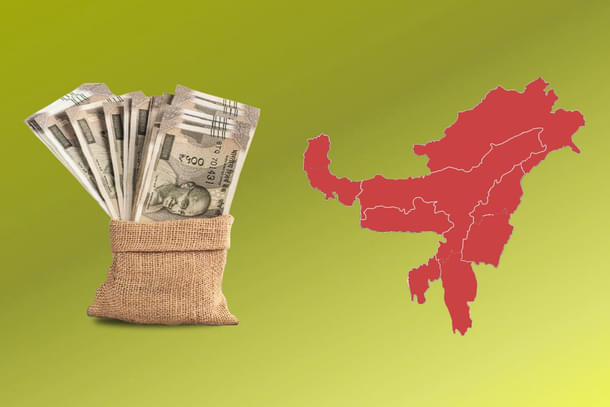Economics
Modi Ensured Connectivity, Northeast Should Now Go All Out To Attract Investments
Pratim Ranjan Bose
Nov 29, 2022, 03:48 PM | Updated 03:41 PM IST
Save & read from anywhere!
Bookmark stories for easy access on any device or the Swarajya app.


Until recently, Arunachal Pradesh in the Northeast was arguably the most remotely connected state in India.
This was partly due to its geography and mostly due to the negligence of Delhi vis-à-vis the hectic infrastructure building on the other side of the border in Tibet.
The Narendra Modi government enforced a dramatic change in the scenario.
Arunachal got its first passenger airport at Pasighat in 2017. As of 2022, it had four such facilities, including the recently inaugurated Rs 640 crore greenfield Donyi Polo airport. More are coming.
The change is secular to the entire Northeast. In 2014, the region had nine airports, most operated in the daytime and looked like glorified cattle sheds. Intra-regional road travel was a back-breaking experience. Rail services were limited and painfully slow.
Today, there are 16 airports. The number of weekly flights doubled. Fast-expanding network of modern highways and broad-gauge rail making the commute easier. Critical healthcare capacities have gone up manifold. Cities are donned with new bridges and flyovers.
Long pending hydropower projects started coming up.
The infrastructure building in the Northeast is far from over. Along with road and rail, inland water transport is also witnessing an overhaul. The refining capacity is being doubled. Indradhanush Gas Grid is connecting every state in the region to the national gas grid.
At one stroke, all disadvantages of the region are removed. No other part of the country has witnessed such a dramatic makeover. And, that takes us to an important awakening, Northeast is no longer infrastructure-deficit.
The goal has shifted to converting this opportunity into regional growth.
Triggering Regional Growth
Part of it has already started happening.
Take the case of Arunachal. The Gross State Domestic Product (GSDP) of the state has nearly doubled in the last six-seven years riding on infrastructure-building activities.
Arunachal is preparing to boost future growth through value tourism and, electricity exports.
As of October 2017, the state had a total installed power generation capacity of 277.96 MW. However, most of these being renewables, marked by seasonality and low-capacity utilization, the state failed to meet the peak demand of roughly 120 MW. There was no surplus.
As the 600 MW Kameng Hydro Power station of North Eastern Electric Power Corporation (NEEPCO) became fully operational this year, Arunachal turned power surplus.
Things will take a more definitive turn with the phased competition of the 2,000 MW Lower Subansiri hydroelectric project, on the Assam-Arunachal border, beginning June 2023.
The government is also considering the Rs 32,000 crore, 2,880 MW Dibang Hydroelectric Project in Arunachal.
The immediate benefits will go to Assam. The largest state in the region suffers up to a 1.5 per cent deficit against a peak electricity demand of 2,300 MW.
Cheap hydropower will help Assam to keep electricity tariffs affordable, replace coal-based power, and better load management. And, as a region Northeast will soon become a power-exporting economy.
Incidentally, both Kameng and Lower Subansiri projects suffered prolonged stalemates during the UPA rule. They were literally revived and completed by the Modi government at three times the original estimates.
A costly lesson for failing to implement infra projects in time.
Need Private Investment
Electricity may be a source of revenue for sparsely populated states like Sikkim, Tripura and Arunachal. With three crore people, Assam has to convert energy security into growth and job creation by attracting investments, preferably in the service sectors.
In the past, Assam (and Northeast) either convinced the public sector to splurge or offered huge subsidies to attract private investments. A good part of Public Sector Unit (PSU) spending didn’t make economic sense.
National Thermal Power Corporation (NTPC) brings coal from Jharkhand to generate electricity in Assam, instead of sending it by wire.
The North East Industrial Investment Promotion Policy (NEIIP), 2007, opened floodgates to subsidy-driven private sector investment. Businesses which use imported raw materials and, market products in the rest of the country, had set up factories in Guwahati.
Sure, some people got jobs but the local value chain creation suffered.
The good news is, Assam is steering away from this model. NEIIP is discontinued in 2017 and investors will stop getting benefits post-2027. Some Fast Moving Consumer Goods (FMCG) and pharmaceuticals players initiated local sourcing.
From now on, Assam has to bank only on its core competence. It has to tap market opportunities in close vicinity, in north Bengal, Bihar and the adjacent economies of Bangladesh, Myanmar, Bhutan etc.
The connectivity push by the government has widened the scope of opportunities. Specific market linkages are to be established by the state governments and the investors. Till that happens, the region should tap the service sector potential.
Guwahati has already emerged as a logistics centre with almost all top companies setting up warehouses here.
According to Biswajit Chakrabarty, senior director of Federation of Indian Chambers of Commerce and Industry (FICCI), they are now extending their presence in the rest of the state and the region.
The last decade witnessed substantial investments both by the government and the private sector in critical and super-critical healthcare. This has reduced the rush of patients to other parts of the country, but export potentials remain untapped.
It is time the Himanta Biswa Sarma government attracts big-ticket private investments in healthcare to get a share of the huge rush of medical tourists from Bangladesh to India.
Opportunities may also be tapped in private higher education, as Odisha did in recent years.
Agriculture And Food
Meanwhile, there is some positive movement in the farm sector in Assam. The region produces a wide range of agriculture and horticulture products.
However, the prevalence of subsistence economy, lack of scale and non-availability of logistics came in the way of tapping value potential in the past.
Over the last couple of years, a few top national and international retailers started procuring select agri-commodities from the state. The quantities are still small but it earned Assam a place in the value chain.
A serious backward integration initiative might help the state in optimising the opportunity in agri-exports. The growing start-up population in the region have already taken the task on itself.
Though their numbers are insignificant compared to bigger centres, start-ups in the Northeast are distinct in their focus on the Agri-Horticultural sector.
The public sector, Numaligarh Refineries Ltd (NRL), for example, is pursuing a bamboo-to-ethanol project. Tissues will be supplied by a local start-up.





